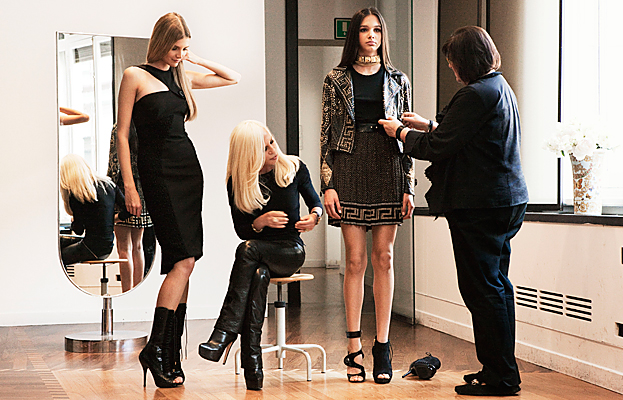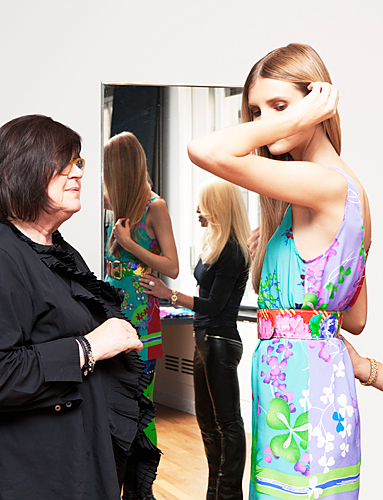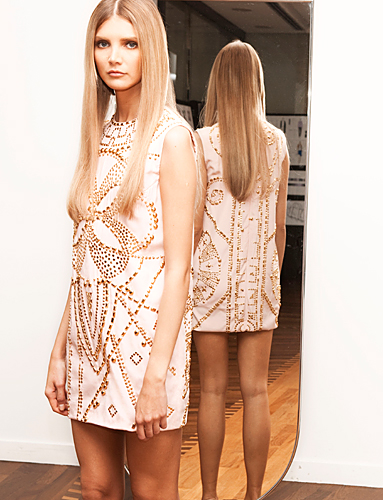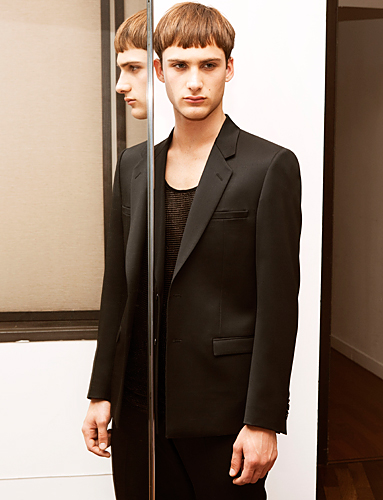
John Galliano arrives at French court on June 22nd. He spoke through a French interpreter, as John Galliano is British.
Before you all read this, I want to make my opinion known. In no way do I condone John Galliano for his remarks and behavior and I do not think his addictions are an excuse, but I do believe he was shit faced drunk. Out of his mind drunk, wasted...gone. He spattered out horrible things like many other drunk people do. We all have seen drunk people, and they do and say stupid shit. Regrettable, despicable things. I do not think his career should be over because of this. I love his work and think he is a genius. He needs help first and foremost. But I do not think he should never design again. I mean, have you seen his work? It's beautiful, brilliant and so
Christian Dior. http://www.style.com/fashionshows/complete/F2011RTW-CDIOR
He made Charlize Theron even more gorgeous:
 Now for the news:
Now for the news:Fashion designer, and former head designer of
Christian Dior John Galliano told a Paris court on Wednesday that he was so out of control on drugs and alcohol he does not recall hurling anti-Semitic insults at strangers in a bar earlier this year.
Looking thinner than in his last public appearance, Galliano arrived in a hushed courtroom wearing long sandy hair, his trademark razor-thin mustache and leather trousers, prepared to defend himself against charges of anti-Semitic behavior.
He stood as a judge read out charges against him and repeated statements he allegedly made in an incident in Paris on Feb. 24, including "dirty Jewish face", "f-king Asian bas-d I will kill you", and "f-king ugly Jewish b-h"
Asked whether he remembered the insults, Galliano said: "I don't remember very well ... I have no recollection."
"I have a triple addiction," he added. "Alcohol, sleeping pills and Valium."
Galliano's career is in tatters. He was fired from fashion house Dior in March, after a video posted online showed him drunkenly telling a woman he loved Hitler and saying her parents might have been gassed in a Nazi death camp.
French police first questioned the British designer in February after a couple accused him of hurling racist abuse at them on the terrace of a cafe.
Designer Galliano Says He Can't Recall Speaking SlursPublished: June 22, 2011
PARIS — In a halting voice, John Galliano, the fallen star designer of the fashion house of Dior, defended himself Wednesday against hate-crime charges by insisting he could not remember spewing anti-Semitic insults in a Parisian bar because of drug and alcohol addictions.
Mr. Galliano, 50, appeared in court wearing a subdued charcoal jacket and open-necked shirt, speaking with the aid of a French interpreter who was replaced by Mr. Galliano’s lawyer when the translator had trouble understanding the English-speaking designer.
“I have addictions, I am recovering from addictions and I am still in treatment,” Mr. Galliano said as he stood facing a panel of three judges. Under questioning, he said his addictions to alcohol, sleeping pills and Valium were a crutch to cope with extreme work pressures and financial crisis.
“The drinking started in a cyclical way. After every creative high I would crash,” Mr. Galliano said, adding that the death of a friend and key aide, along with work pressures, exacerbated his drinking.
“Dior is a big machine and I didn't want to lose Galliano,” he said of his own label, which is majority owned by Dior. He complained about suffering panic attacks as he struggled to raise new revenues for his brands for everything from children’s underwear to menswear.
For the one-day trial, the judges evaluated testimony of about a half-dozen witnesses and watched a grainy, 45-second cellphone video that shows Mr. Galliano speaking in a slurred voice. The witnesses testified about two incidents, in October and February, both at a bar in the Marais, La Perle. The video, which involves a third dispute that was not part of the trial, was allowed as evidence.
The actual crime of which he stands accused — public insults about religion, race, or ethnicity — ordinarily ensnares far-right politicians with a clear ideology. The crime carries a penalty of up to six months in prison and a fine of €22,500, or $32,400, though usually the maximum fine is not imposed. As the trial still continuing into the evening, it was unclear when a verdict would be issued.
Despite the attention surrounding his trial, the John Galliano label will go ahead with plans to stage a show Friday of his menswear line for Paris fashion week, which also began on Wednesday.
But for Mr. Galliano, there was no red carpet on Wednesday, just the bare parquet floor in a wood-paneled French courtroom, where a young couple in their 30s testified in detail about their encounter with Mr. Galliano at La Perle, a clash that ultimately resulted in his being fired by Dior.
Mr. Galliano insisted that he had no recollection of the venomous language that witnesses described, or of the comments he made in the 45-second video, which had been widely circulated online, showing Mr. Galliano slurring his words and declaring, among other things, “I love Hitler.”
“He had different expressions, dirty Jew, Dirty Jewish face,” recalled Geraldine Bloch, an art curator whose visit to the bar exploded into a 45-minute encounter with Mr. Galliano in late February.
“At a certain point, he told us to leave because he said I was in his bar and his neighborhood. He finished by saying, ‘I am John Galliano,”’ she said, noting that he also peppered his comments with observations about her hair and what he called her “revolting” eyebrows and boots.
After the video was viewed in court on a wide screen, Mr. Galliano stood and faced the judges and spoke about himself, sometimes in the third person.
“I never had these views all my life,” he said. “These are not the sentiments of John Galliano.”
Ultimately, Mr. Galliano apologized for his behavior, including the video and the dispute with the couple. He said that he himself had faced discrimination for being gay.
“On the video, I see someone who needs help and is very vulnerable,” he said. “It’s the shell of John Galliano.”
Dubbed fashion’s bad boy for his flamboyant and provocative style, Mr. Galliano had helped to energize Dior since he joined in 1996 as creative director, increasing sales and making it one of the jewels of the LVMH Moët Hennessy Louis Vuitton luxury empire, run by the billionaire Bernard Arnault.
Yet in court, that flamboyance had vanished. He spoke so quietly that the judge pushed him several times to speak into a microphone.
For every witness who declared a list of insults, he responded in a tired voice that he could not remember.
“I was in denial,” he said. “I was taking all those pills and alcohol. I was in complete denial. I am still in recovery. But I am feeling much better.”
The hearing, which started about 4 p.m. and continued for more than four hours, also included witnesses who said they had not heard any anti-Semitic remarks made by Mr. Galliano. One supportive witness was an English-language teacher.
Others have fashion industry ties — an American fashion student and a public relations employee who represents fashion firms.
At one point, the presiding judge, Anne-Marie Sauteraud, asked his current profession.
“I have none,” he said, almost inaudibly.
Then he issued a plea to the judge to take note of his work, inspired by his travel to diverse countries.
“I know what it feels to be discriminated against,” Mr. Galliano testified, noting that his real name is Juan and that his mother is Spanish. “We moved to south London when I was 6 years old and aware that I was gay. I was sent to a difficult English boys school and you can imagine that children can be cruel.”
Galliano Scandal Timeline:Galliano was arrested and taken to a police station for a sobriety test, where he was found to be just over the legal limit. Police then escorted him to his home.
February 28, 2011: Galliano is been suspended from Dior. The designer visits a police station in Paris to answer questions about the incident. Just hours earlier, a video emerged of him apparently praising Hitler in a separate incident.
Another woman later comes forward to say she suffered a similar attack in October last year.
March 1, 2011: Oscar-winning actress Natalie Portman, who is the face of Christian Dior's Miss Dior Cherie fragrance, issues a statement condemning Galliano over the video. "I am deeply shocked and disgusted by the video of John Galliano's comments that surfaced today. In light of this video, and as an individual who is proud to be Jewish, I will not be associated with Mr Galliano in any way. I hope at the very least, these terrible comments remind us to reflect and act upon combating these still-existing prejudices that are the opposite of all that is beautiful."
Dior confirms that it has sacked Galliano in light of the video.
March 4, 2011: The Dior show goes ahead during Paris Fashion Week, without Galliano. Dior's CEO, Sidney Toledano, took to the stage before minutes before the curtains were raised to give a moving speech: "What has happened over the last week has been a terrible and wrenching ordeal for us all. It has been deeply painful to see the Dior name associated with the disgraceful statements attributed to its designer. However brilliant he may be." With Galliano gone, speculation then fell to who would replace him at the luxury house, with Riccardo Tisci of Givenchy, Haider Ackermann and Alber Elbaz of Lanvin all apparently in the frame April 15, 2011: things go from bad to worse for the disgraced designer after he is ousted by the board of his namesake label, 91 per cent of which is owned by Dior.
May 3, 2011: rumours circulate that Stephane Zerbib, Galliano's lawyer in the case, has quit; Zerbib had previously defended his client in an outspoken interview with an Israeli newspaper. However, a spokesman for Galliano issued a statement saying Zerbib was "dismissed as Monsieur Galliano's lawyer some weeks ago."
June 22: Galliano is due to face charges in a French court over the alleged racist tirades at a Paris bar, which the fallen designer will blame on drug and alcohol addiction. If found guilty, the 50-year-old couturier - considered one of the finest fashion designers of his generation - could face a sentence of six months in jail and a fine of 22,500 euros (£20,000).













![[TOT]](http://si.wsj.net/public/resources/images/PJ-BB348_TOT_DV_20110615185248.jpg)
![[TOT]](http://si.wsj.net/public/resources/images/PJ-BB349A_TOT_DV_20110615185359.jpg)
 Check this out.
Check this out.